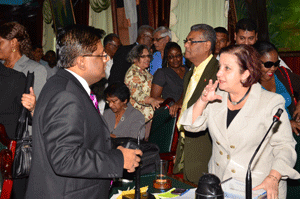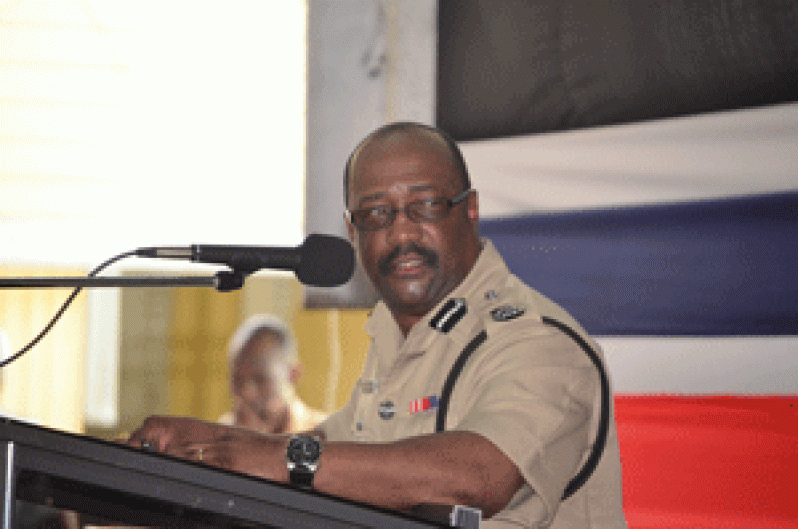WHILE replanting of mangroves along Guyana’s coastline by the Guyana Mangrove Restoration Project (GMRP) has seen success in excess of 50 percent at most of the sites, some sites have not been as successful and consequently various innovations are now being implemented.
 During a visit to various mangrove sites along the East Coast of Demerara yesterday, Minister of Agriculture, Dr. Leslie Ramsammy said that a major component of the project is research into coastal engineering, such as the use of geotextile tubes, rubble mound groynes, brushwood groynes and the growing of spartina to aid in the growth of mangroves.
During a visit to various mangrove sites along the East Coast of Demerara yesterday, Minister of Agriculture, Dr. Leslie Ramsammy said that a major component of the project is research into coastal engineering, such as the use of geotextile tubes, rubble mound groynes, brushwood groynes and the growing of spartina to aid in the growth of mangroves.
He stated that these innovations will be examined to see which is the best option to be used more often in Guyana.
The site at Mon Repos has a rubble mound groyne, which is made of boulders (large rocks), while at Buxton there is a brushwood dam made from bamboo. These serve to break the force of the water and encourage sedimentation, providing an environment more conducive to the growing of mangroves.
The minister and a technical team comprising Chief Executive Officer (CEO) of the National Agricultural Research and Extension Institute (NAREI), Dr. Oudho Homenauth, Project Engineer Luandra Jack and Project Coordinator Kene Moseley also visited the mangrove site at Victoria where a geotextile tube has been installed.
Ramsammy said that the geotextile tube is one of the innovations which will be used more in Guyana. According to him, the one at Victoria is in its preliminary stage and already evidence of its success can be seen.
He noted that the conditions that had existed in that area prior to the installation of the geotextile tube did not allow the growth of anything. However, he said that since that innovation is in place, spartina grass has begun to grow in addition to a few mangrove plants.
The minister stated that planting of mangroves at that site will begin in the near future since indications are that the area is ready to have mangrove growing.
SUCCESS STORY
He stressed that the project is already a success story and that it is something that is being used as an example in other countries.
Moreover, as a part of the GMRP, spartina grass is also being grown at various sites which help to solidify the soil to make it more suitable for mangrove growing.
The team visited the Le Resouvenir/Felicity site which has some 1.6 kilometres of mangroves, which were planted starting in May 2012.
Ramsammy said that replanting in this area was very successful, with a 90 percent survival rate of plants. He added that mangroves in the area are not only planted, but those planted also generate new plants.
14 MANGROVE SITES
Noting that there are some 14 mangrove sites in various locations around the country, the minister said that in addition to seawalls and other structures, mangroves provide protection from the sea and hopefully as sea level rises and as climate change becomes more extreme, Guyana will be ready to face these challenges.
He further noted that replanting of mangroves is only one component of the project, as it also provides opportunities for research. As such, he said, a team of young researchers on mangrove protection is being established.
In addition, he said that it provides community support because the people who plant the mangroves, as well as the rangers who protect the mangroves, are from the communities.
According to the minister, the GMRP is a Guyana government project but rather it is more of a programme because it is continuous. He stressed that whether any partner joins the government or not, the project will continue.
He indicated that a 2014 budget for the mangrove unit and the mangrove programme has already been submitted.
EU PARTNER
However, he noted that for a period that comes to an end in December but there has been a project component to the programme for which the European Union (EU) has been a very important partner.
“We are very grateful for their support through budgetary support to the government, and we hope that when this project comes to an end that partners such as the EU and we hope other partners will join us as we expand the programme across our country,” he asserted.
Moreover, Ramsammy stated that Guyana hopes to join with other countries such as Suriname and French Guiana to ensure that the coastal areas and also inland areas are afforded protection against global warming and climate change.
He also related that in the initial stages of the project there were some difficulties as fishermen were moving their boats among the mangroves, destroying the plants. However, the fishermen now see it as an important part of protecting the country and the project also considers the fishermen.



.jpg)









